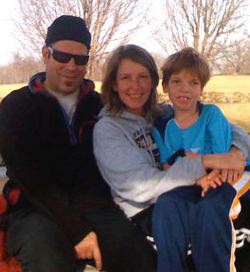Thomas Henry Taylor
|
| January 31, 1962 ~ July
31, 2011 |
|
September 4, 2011 |
by Bart Barnes
The Washington Post
 Tom
Taylor tried being a forest ranger, brew master,
carpenter, lab technician, ranch hand, house
painter, construction worker and computer
manager. He was in his late 30s before he found
his calling as a physician and specialist in
gastroenterology. Tom
Taylor tried being a forest ranger, brew master,
carpenter, lab technician, ranch hand, house
painter, construction worker and computer
manager. He was in his late 30s before he found
his calling as a physician and specialist in
gastroenterology.
For 13 years, he trained and practiced, in
college pre-med courses, medical school,
hospital internships, residencies and
fellowships. In July, at the age of 49, he began
an appointment to the medical gastroenterology
staff at Dartmouth-Hitchcock Medical Center in
Lebanon, New Hampshire, and soon after met his
first patients there.
He died July 31, 2011, in a Sunday afternoon
traffic accident on a bridge in rural New
Hampshire. His van was struck head-on by a car
coming from the opposite direction in the town
of Carroll, according to his father and news
reports, and he died instantly. His wife,
Kristin, the daughter of Larry and Wilma
Wallace, Bonners Ferry, and his sons, James and
Benjamin, were with him on a family outing to
Mount Washington. They suffered injuries that
were not life threatening.
Thomas Henry Tayor, a native of Washington,
D.C., who was born January 31, 1962, grew up in
southern Maryland. He had always marched to his
own tune. In childhood and adolescence, he did
well in school, but to him the routines and
strictures were vexing. After graduating from
McDonough High School in Charles County, he had
little or no interest in attending a traditional
college, although he had the grades to do so.
Instead, he chose an alternative path, the
Sterling Institute in Craftsbury Common,
Vermont, where he studied forestry in a program
that emphasized experimental learning, teamwork
and personal bonding. He loved the outdoors and
he was a natural handyman. On construction jobs,
which he held from time to time, he could
usually figure out how to fix malfunctioning
equipment.
He later graduated from the university of
Vermont, where he majored in geology. He then
earned his living as a house painter and as a
maintenance worker on the Appalachian Trail. He
was a forest ranger at Bob Marshall Wilderness
in Montana and at Selway Bitterroot Wilderness
in Idaho and Montana. He hiked and learned to
manage trains of pack mules.
In Marin County, California, he supervised a
church retreat house. In Chicago, he studied
methods of brewing beer, and he was planning a
brew pub in California.
His studied of brewing rekindled a dormant
interest in science, and he was feeling that he
should, perhaps, try "doing something for the
common good," said his wife, Kristin Wallace
Taylor.
He thought about a career in medicine, and he
began volunteering nights at the emergency room
at San Francisco General Hospital in the late
1990s while pursuing pre-med courses at the
University of California at Berkeley. He liked
it and decided to make a change.
"Tom Taylor abhors tedium. In fact, he delights
in drastic change," a National Public Radio
reporter said of him in a 2005 program about
career changes at midlife.
At 38, the future physician put aside his brew
pub plans, returned to Washington, D.C., and
enrolled at the Georgetown University School of
Medicine. About 15 years older than most of his
classmates, he was known as the "class dad." In
2004, he graduated.
"Stocky, affable and brown-bearded," according
to an NPR description, Dr. Taylor was gentle and
caring toward patients, and he won an award for
his bedside manner.
He was in Portland, Oregon, for three years of
medical residency and then returned to
Georgetown for a medical fellowship. In June, he
moved to New Hampshire for the job at Dartmouth.
Two weeks after Dr. Taylor's death, Kristin
returned to her native Idaho with their two
children. They are now living with her parents
in Bonners Ferry.
Other survivors include Dr. Taylor's parents,
the Reverend Arnold G. Taylor and Lillian B.
Taylor, Washington, D.C., and two sisters; Alice
Taylor, Arlington County, and Laura Taylor,
Carlisle, Pennsylvania.
"I think one of the remarkable things about
being a human being is our ability to transform
ourselves," Dr. Taylor told NPR in the 2005
program. "If you really want to make a change
and you can see a path to do it, I think you
should do it at any age." |
|
|

